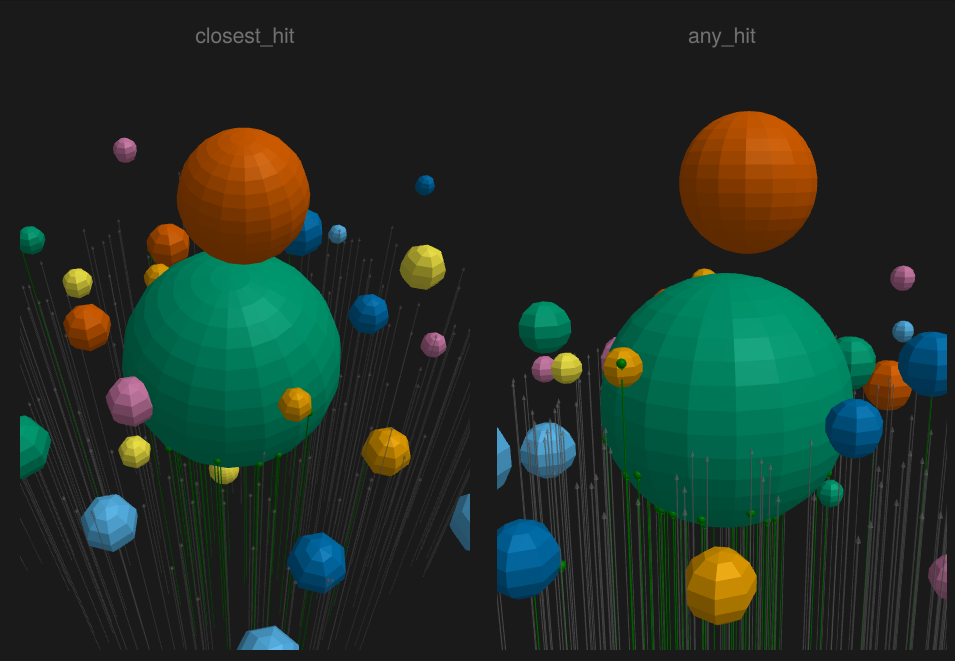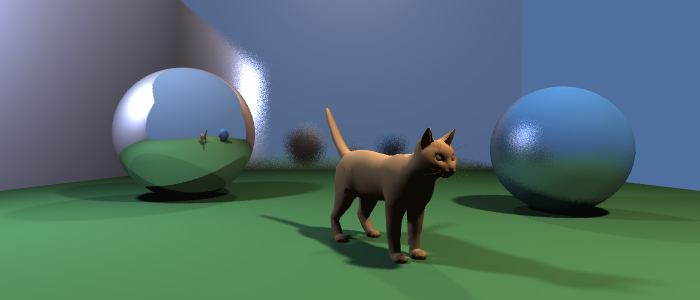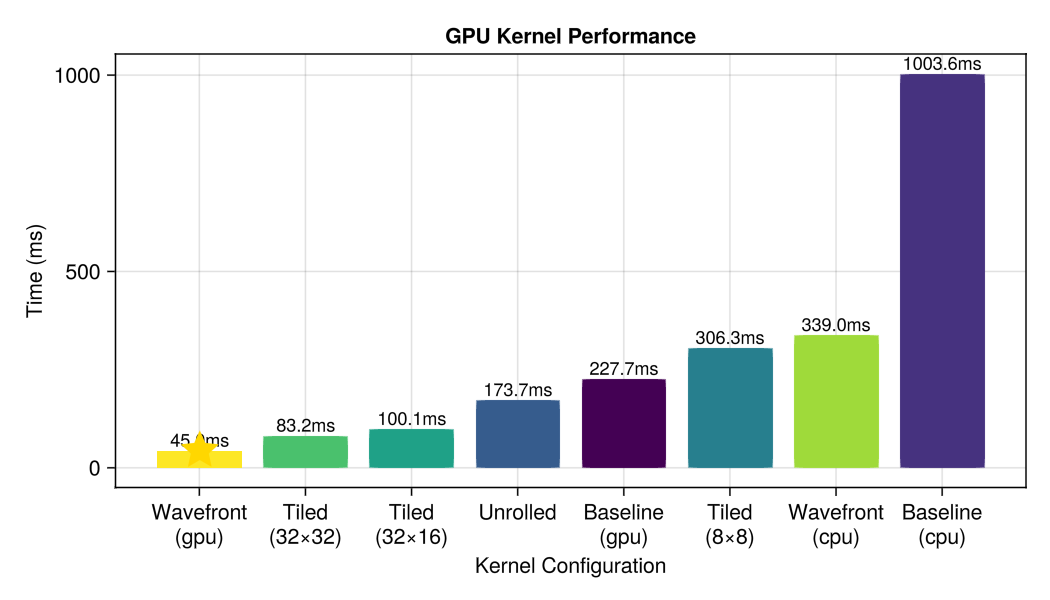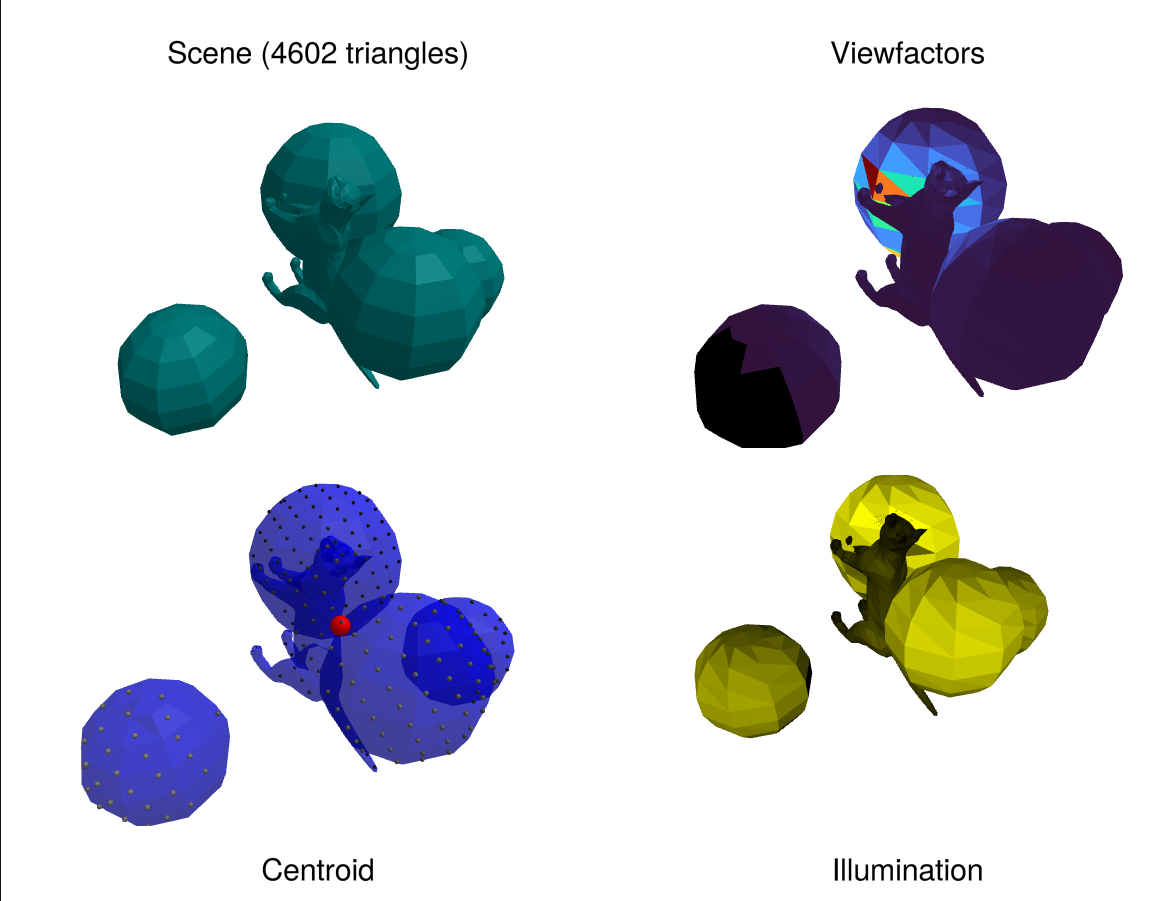Raycore.jl
High-performance ray-triangle intersection engine with BVH acceleration for CPU and GPU.
Features
- Fast BVH acceleration for ray-triangle intersection
- CPU and GPU support via KernelAbstractions.jl
- Analysis tools: centroid calculation, illumination analysis, view factors for radiosity
- Makie integration for visualization
Interactive Examples
BVH Hit Tests & Basics
Learn the basics of ray-triangle intersection, BVH construction, and visualization.

Ray Tracing Tutorial
Build a complete ray tracer from scratch with shadows, materials, reflections, and tone mapping.

GPU Ray Tracing Tutorial
Port the ray tracer to the GPU with KernelAbstractions.jl. Learn about kernel optimization, loop unrolling, tiling, and wavefront rendering.

View Factors Analysis
Calculate view factors, illumination, and centroids for radiosity and thermal analysis.

Overview
Raycore.BVH — Type
BVH{NodeVec, TriVec, OrigTriVec}GPU-optimized BVH acceleration structure.
Key optimizations:
- Uses LinearBVH node structure (flat array, depth-first layout)
- Pre-transforms triangles with edge vectors for Möller-Trumbore
- Designed for efficient GPU kernel traversal
Fields:
- nodes: LinearBVH nodes (flat array, depth-first layout)
- triangles: Pre-transformed compact triangles
- primitives: Original triangles (for normals, UVs, materials)
- maxnodeprimitives: Maximum primitives per leaf node
Raycore.BVH — Method
BVH(primitives::AbstractVector, max_node_primitives::Integer=1)Construct a BVH acceleration structure from a list of primitives (meshes or geometries).
Arguments:
primitives: Vector of triangle meshes or GeometryBasics geometriesmax_node_primitives: Maximum number of primitives per leaf node (default: 1)
Returns a GPU-optimized BVH with pre-transformed triangles for efficient ray tracing.
Raycore.RayIntersectionSession — Type
RayIntersectionSession{F}Represents a ray tracing session containing rays, a BVH structure, a hit function, and the computed intersection results.
Fields
rays::Vector{<:AbstractRay}: Array of rays to tracebvh::BVH: BVH acceleration structure to intersect againsthit_function::F: Function to use for intersection testing (e.g.,closest_hitorany_hit)hits::Vector{Tuple{Bool, Triangle, Float32, Point3f}}: Results of hit_function applied to each ray
Example
using Raycore, GeometryBasics
# Create BVH from geometry
sphere = Tesselation(Sphere(Point3f(0, 0, 1), 1.0f0), 20)
bvh = Raycore.BVH([sphere])
# Create rays
rays = [
Raycore.Ray(Point3f(0, 0, -5), Vec3f(0, 0, 1)),
Raycore.Ray(Point3f(1, 0, -5), Vec3f(0, 0, 1)),
]
# Create session
session = RayIntersectionSession(rays, bvh, Raycore.closest_hit)
# Access results
for (i, hit) in enumerate(session.hits)
hit_found, primitive, distance, bary_coords = hit
if hit_found
println("Ray $i hit at distance $distance")
end
endRaycore.any_hit — Function
any_hit(bvh::BVH, ray::AbstractRay)Test if a ray intersects any primitive in the GPU BVH (for occlusion testing). Stops at the first intersection found.
Returns:
hit_found: Boolean indicating if any intersection was foundhit_primitive: The primitive that was hit (if any)distance: Distance along the ray to the hit point (hit_point = ray.o + ray.d * distance)barycentric_coords: Barycentric coordinates of the hit point
Raycore.closest_hit — Function
closest_hit(bvh::BVH, ray::AbstractRay)Find the closest intersection between a ray and the GPU BVH. Uses manual traversal with compact triangle intersection for best performance.
Returns:
hit_found: Boolean indicating if an intersection was foundhit_primitive: The primitive that was hit (if any)distance: Distance along the ray to the hit point (hit_point = ray.o + ray.d * distance)barycentric_coords: Barycentric coordinates of the hit point
Raycore.hit_count — Method
hit_count(session::RayIntersectionSession)Count the number of rays that hit geometry in the session.
Raycore.hit_distances — Method
hit_distances(session::RayIntersectionSession)Extract all hit distances from a RayIntersectionSession.
Returns a vector of Float32 containing distances for all rays that intersected geometry.
Raycore.hit_points — Method
hit_points(session::RayIntersectionSession)Extract all valid hit points from a RayIntersectionSession.
Returns a vector of Point3f containing the world-space hit points for all rays that intersected geometry.
Raycore.miss_count — Method
miss_count(session::RayIntersectionSession)Count the number of rays that missed all geometry in the session.
Raycore.reflect — Method
Reflect wo about n.
Private Functions
Raycore.CompactTriangle — Type
CompactTrianglePre-transformed triangle data for efficient GPU ray-triangle intersection. Uses edge vectors for Möller-Trumbore intersection algorithm.
Fields:
- v0: First vertex position (4th component for alignment)
- edge1: v1 - v0 edge vector
- edge2: v2 - v0 edge vector
- normal: Face normal (4th component for alignment)
Raycore.cos_θ — Method
The shading coordinate system gives a frame for expressing directions in spherical coordinates (θ, ϕ). The angle θ is measured from the given direction to the z-axis and ϕ is the angle formed with the x-axis after projection of the direction onto xy-plane.
Since normal is (0, 0, 1) → cos_θ = n · w = (0, 0, 1) ⋅ w = w.z.
Raycore.face_forward — Method
Flip normal n so that it lies in the same hemisphere as v.
Raycore.generate_ray_grid — Method
generate_ray_grid(bvh::BVH, ray_direction::Vec3f, grid_size::Int)Generate a grid of ray origins based on the BVH bounding box and a given ray direction.
Raycore.intersect_compact_triangle — Method
intersect_compact_triangle(tri::CompactTriangle, ray_o, ray_d, t_max)Watertight Möller-Trumbore ray-triangle intersection for GPU. Uses pre-computed edge vectors for efficiency.
Returns: (hit, t, u, v) where u,v are barycentric coordinates
Raycore.intersect_p — Method
dirisnegative: 1 – false, 2 – true
Raycore.maximum_extent — Method
Return index of the longest axis. Useful for deciding which axis to subdivide, when building ray-tracing acceleration structures.
1 - x, 2 - y, 3 - z.
Raycore.offset — Method
Get offset of a point from the minimum point of the bounds.
Raycore.to_compact_triangle — Method
to_compact_triangle(tri::Triangle) -> CompactTriangleConvert a Triangle to CompactTriangle format with pre-computed edge vectors.